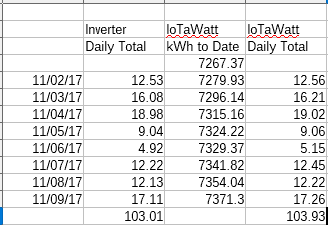Over the past week, I’ve kept a detailed accounting of several channels on two different IoTaWatt that I have in my home, as well as a third that is installed in another site with a PV system. In my home, the town has recently repleced my meter with a brand new electronic meter so they can read it remotely. By definition it is revenue grade. The display has a resolution of 1kWh, so it’s +/- 1kWh. Waiting for a week I’ve used 237kWh so that’s +/- 0.4%.
I also have two electronic meters made by a company called EKM. Here are the specifications. I have these meters on my electric water heater (so resistive load), and on my heat-pump (PF .88-.89).

The solar installation has a Solar Edge inverter which uploads generation to their website and can be viewed through a user portal. Those generation numbers are also used to determine SREC credits.

These are standard IoTaWatt with only the standard voltage calibration. CTs are a mix of SCT019-000, SCT013-000, and HWCT-004, all using the standard configuration data.
There is an ongoing check of an IoTaWatt on the UK power grid that is comparing a pulse meter counter with an IoTaWatt measurement of the same service. Looking to hear of other’s experience.